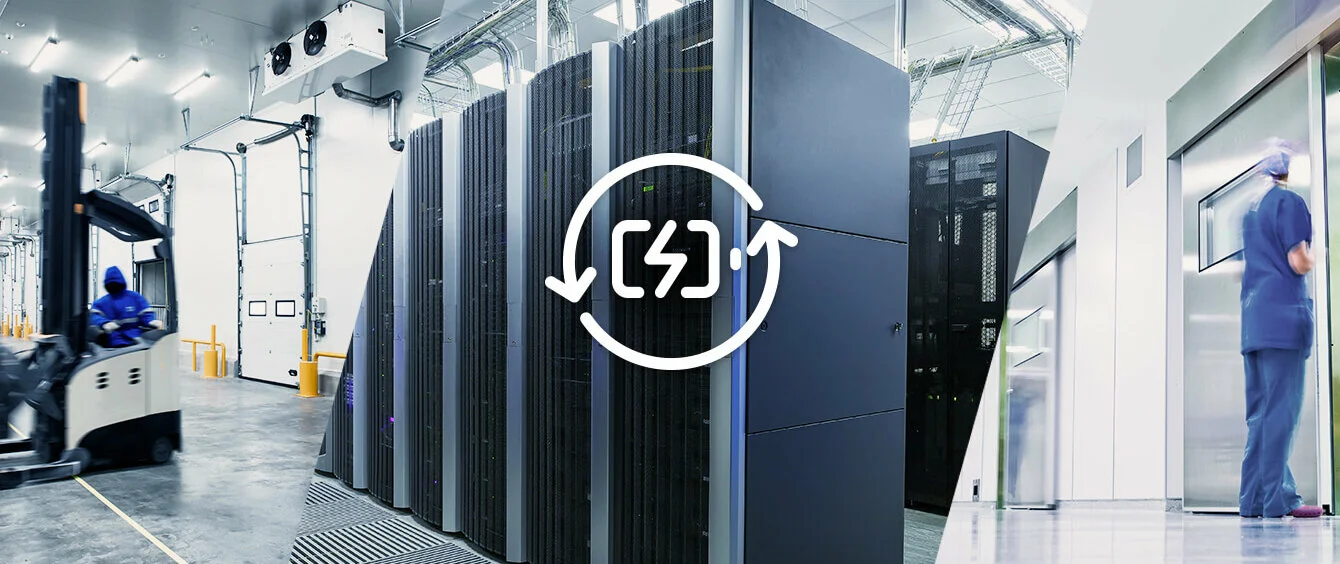Power cuts in computer centres can have dramatic consequences: Data loss can result in million in damages or, in extreme cases, even cause entire national economies to grind to a halt. In hospitals, blackouts can even endanger human lives if, for example, the respirator cuts out during an operation.
Many such institutions operate emergency standby generators for this very reason. If the public power grid fails, these units jump in to supply the required electricity in a matter of milliseconds. In Germany, this is luckily very rarely the case: On average, an electricity customer experiences this sort of incident less than once every four years, with the event lasting approximately less than an hour.
The emergency standby power supply is generally secured by a combination of a battery unit – for uninterruptible power supply (UPS) – and an emergency standby diesel generator. The UPS battery regulates the power supply until the generator is up and running. The battery is then automatically recharged.
The acquisition and running costs of emergency standby generators are high and the units are rarely used, resulting in considerable electricity generation capacity being wasted. The operators of these units are only slowly beginning to harness this potential. They are able to earn money by providing what is referred to as operating reserves: Network operators pay the unit operators for the ability to use the units to stabilise the power grid.
Operating reserves for stable networks
The voltage of the power grid is delicate. In order to maintain the European network frequency of 50 hertz, supply and demand must always be balanced. Considerable wind and solar power capacities have been added in recent years. Their future production is estimated via forecast models. However, forecast deviations are possible. An example: If the electricity, generated by wind power, has been overestimated, current electricity demand exceeds electricity supply. This then has to be bridged with capacity reserves, known as positive operating energy. Suitable units must feed additional electricity into the grid in a matter of seconds or minutes, in order to guarantee network stability.
This is where emergency standby generators come into play. They are activated remotely and incorporated into a ‘virtual power plant’: Battery units feed stored electricity into the grid. Diesel generators can bridge sudden supply reductions. The emergency standby units generate operating reserve, thus increasing the stability of the power grid. Operators are compensated for this service.
An operating reserve of approximately 4,000 MW is being wasted in relation to emergency standby diesel generators
The potential for this market is enormous. Emergency standby power systems can be found in numerous institutions such as hospitals, airports, water and sewage plants, IT companies, cold stores, telecommunications companies and computer centres. Experts estimate that there are between 4,000 and 6,000 emergency standby diesel generators of varying capacities in Germany, according to the industry portal for computer centres Datacenter-Insider. The power generation capacities of these facilities are estimated to be around 4,000 Megawatt (MW). The larger computer centres alone could supply more than 800 MW, according to calculations of the research institute.
RWE brings UPS battery units and emergency standby diesel generators to the market
RWE Supply & Trading has developed a multi-functional battery unit for computer centres, together with partner company Riello Power Systems. This new CPS battery system is known as Master+. The recently launched pilot plant includes two Master+ systems with 200 kW of power apiece and two high-performance Hoppecke batteries rated at a nominal 192 kWh.
Master+ UPS-Battery
RWE is making the storage capacity of these batteries available to the operating reserve market. In this way, the battery is permanently monitored and in operation. The battery’s storage capacity is used to minimise fluctuations in the public power grid caused by renewables, for example. “The Master+-UPS-Unit lowers the operating and capital costs of critical infrastructure operators, such as computer centres, whilst simultaneously increasing security of supply”, explains Hans-Günter Schwarz, Head of New Business Concepts at RWE Supply & Trading. Master+ will be available from early 2019.
In tandem, RWE Supply & Trading is also offering optimised trial operations of emergency standby diesel generators. However, RWE Supply & Trading is not alone in harnessing the potential for “dormant” emergency standby generators. Many, often regional, power suppliers combine forces under the generic term „virtual power plant“ to provide operating energy.
However, RWE Supply & Trading’s concept extends much further: RWE’s multi-use concept flexibly implements the trial features of the emergency standby generators, allowing for what is known as a decentralised feed-in fee, in addition to the ability to provide said secondary operative reserve. This generates savings in terms of customer grid usage. Purchasing emergency standby generators is only economically incentivised once this combination of multiple revenue possibilities is taken into account.
The original emergency standby function and the security of the units remain completely unaffected. Should it come to an extension of trial operating hours within the scope of the optimisation, this would be so minimal that the potential for additional maintenance and service costs could be disregarded. The optimised trial operation at high or full load moreover helps avoid partial-load tests which can lead to technical problems (‘wet stacking’), which can damage the units.
In this way, larger computer centres can generate six-figure revenues, according to Datacenter-Insider. Nevertheless, emergency planning takes precedent. The unit is only used in such a way that does not disrupt the electricity supply should it come to an emergency.
Photo credits: Timofeev Vladimir, shutterstock.com; Kokliang, shutterstock.com; VILevi, shutterstock.com
